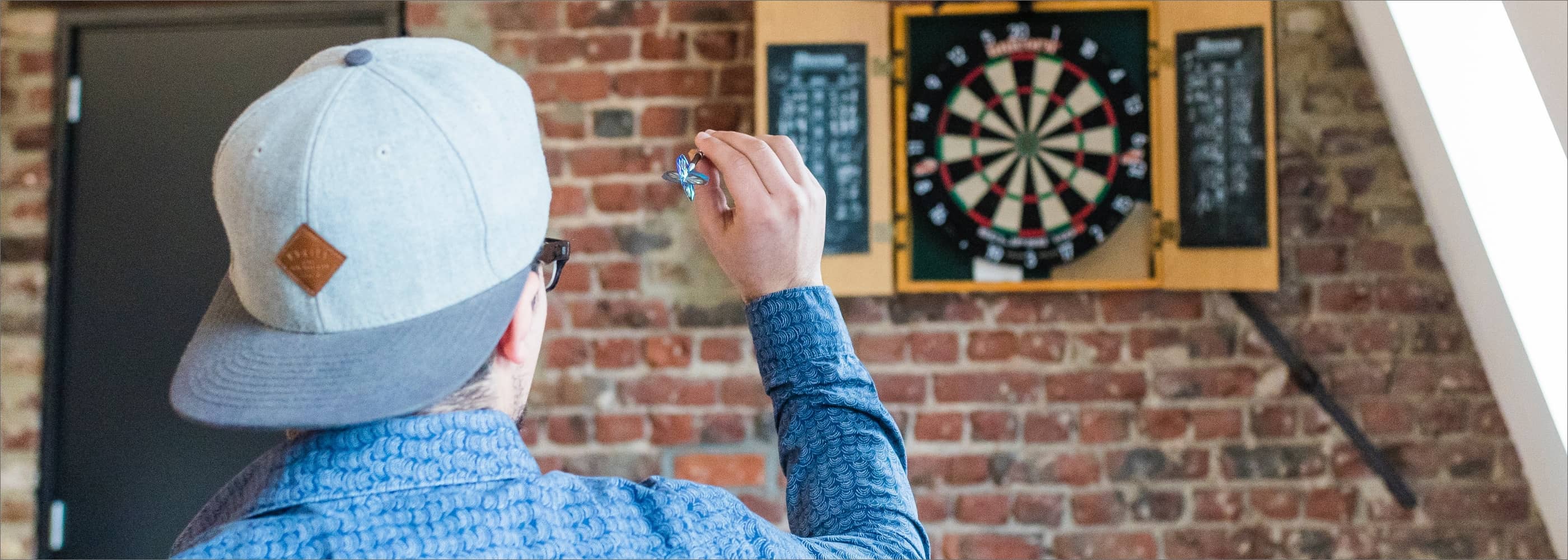A Megfelelő Pozíció: Az Optimális Dobás Fontos Eleme
A dartsban az optimális beállás kulcsfontosságú. Sok játékosban felmerül a kérdés: középen vagy oldalra álljak? A PDC színpadán mindegyikre számos példát lehet találni, így - mint a legtöbb dolog a dartsban – ez is saját preferencia kérdése. Ha egy kicsit elrugaszkodunk és megközelítjük a kérdést a fizika oldaláról – lévén, hogy az egész dobás leírható a fizikában ismert törvényekkel – akkor kijelenthetjük, hogy az optimális beálláshoz célszerű középre helyezkedni. Ebben az esetben a törzsünk elforgatásával ugyan arra az erő kifejtésre, mozdulatra, elengedési pontra, célzásra van szükségünk akár a D11 vagy a D6-ra akarunk éppen dobni, mert ugyanolyan távolságra vannak tőled. Ezáltal az izmaidnak és az agyadnak feleződik a megtanulandó mozdulatsorok száma (tábla bal és jobb oldala). Emellett a középre való beállással elkerülöd, hogy a nyilak ferde szögben érjék el a táblát, ami blokkolhatja a következő nyilad útját, ezáltal nehezebbé téve a játékot. Ahogyan egyre több a profi játékos és egyre nagyobb népszerűségnek örvend a darts úgy válik ez a sport is csak úgy, mint a foci, az NFL vagy bármelyik élsport a tudomány áldozatává, ami természetesen jól használva előnyt tud biztosítani.
Testtartás és Dobás: A Megfelelő Szem Használata a Pontosságért
A megfelelő testtartás és dobástechnika összehangolása létfontosságú viszont ezeken túl fontos tisztában lenned azzal is, hogy melyik szemed a domináns, melyik az amivel valóban célzol és a dobó mozdulatot ennek megfelelően célszerű igazítani. A leggyorsabb eredmények akkor érhetők el, ha a célzó szemed és a célpont között meghúzott egyenesen halad végig a dobás mozdulata, így azonnal észreveszed már a dobás közben, hogy ha belerántottál a dobásba, kitört oldalra a könyököd stb. Továbbá az egyik legfontosabb tényezők közé tartozik az alap beállásod stabilitása és kényelmessége. Végeredményben ebben a helyzetben kifejezetten sok időt fogsz eltölteni és arra kell koncentrálnod, hogy eltaláld, amit szeretnél. A fizikális megterhelése sem elhanyagolható egyes beállási típusoknak a legnagyobbak között például Michael Van Gerwen nagy mértékben megterheli a derekat ezért nem is sokan váélasztják azt, hogy ennyire előre dőljenek.
Az Alap Beállás: Amikor Nem Középre Dobsz
Az alap beállás mindig a tábla közepére van optimalizálva, pontosabban a T20-r. Lévén, hogy ez a legértékesebb és egyben legtöbbször dobott szektor az X01 játéktípusban nem meglepő. Viszont nem szabad elfeledkezni arról, hogy nem kizárólag oda dob az ember, így nagy segítség, ha az olal irányban eltérő célpontok esetén elmondom, hogy mit módosíts a dobás közben. Ha oldalirányba dobsz, szélsőséges esetben (pl. D11 vagy D6 felé), a legtöbb kezdő elköveti a hibát, hogy a korrekciót vállból végzi el. Azért mondom, hogy ez hiba, mert ebben ez esetben megváltozik a dobásnál sok tényező, amit észre sem veszel feltétlenül, így gyakorlatilag az izmaidnak egy másik dobás mozdulatot kell megtanulnia függően attól, hogy hova célzol. Mondanom sem kell, hogy egyszerűbb, ha ezt a változót kihúzod a képletből és az ilyen esetekben a törzsedet használod a korrekció túlnyomó részének korrigálására. Viszont arra figyelj, hogy nem beszélünk nagy fordulásról hiszen, ha törzsből elforogsz 1 fokot az a táblába érkező nyílnál már kb.3 cm-ként fog megjelenni, úgyhogy csak finoman.
Stabil Beállás: A Megfelelő Súlyelosztás, Mint a Pontosság Alapja
Ugyan úgy ahogyan abból a bizonyosból sem lehet várat építeni, ha instabil a beállásod, aminek köszönhetően akár minden dobásnál megbillensz az hosszú távon nem lesz célra vezető. A stabil beállás alapját a megfelelő súlyelosztás adja. Szándékosan szélsőségről beszélek de például, ha az első lábra helyezed a súlyod túlnyomó részét (95-99%), hogy még fél centivel közelebb legyél a táblához azzal végeredményben ártani fogsz a játékodnak nem pedig segíteni azon. A végleges súlyeloszlás teljesen rajtad áll - ugyan úgy, mint bármi más - ami kényelmes, viszont célszerű, hogy az elülső lábadon legyen a testsúlyod nagyobb része, így a stabil beálláshoz az első lábadon (jobb kezesek esetén jobb láb) a testsúly 55-85% kell, hogy legyen.
A Nyíl Fogása: Az Egyéni Kényelem Eredményessége
Első és legfontosabb, nem szabad eröltetni, hogy mások beállását vagy mozdulatait lemásold, mert jól néz ki és te így akarsz dobni. Persze célszerű ellesni bizonyos dolgokat a legnagyobbaktól viszont, ha valami számodra kényelmetlen és teljesen idegen akkor az adott mozdulat sokkal inkább fog hátráltatni, mint sem segíteni téged a fejlődésben. Minél inkább természetszerű a dobásod és minél kevesebb részét kell tudatosan fent tartanod minden egyes elengedésnél annál egyszerűbb lesz reprodukálni az adott mozdulatot. Természetesen, ha a mozdulat sorodban van olyan tényező, amit nem tudsz megismételni és mindig picit más akkor azt célszerű tudatosan felülírni és kicserélni a lehető legjobb megoldással. Nem akarok túl mélyre menni, de leggyakoribb példaként fel tudom hozni a kéz elengedés után útját. A legtöbb kezdőnek az jön reflexszerűen, hogy amint elengedte a nyilat kvázi megállítja annak további mozgását. Ezzel az a gond, hogy ha adott dobásnál egy picit később engeded el a nyiladat akkor már a dobásba fogsz belerántani, így drasztikusan módosítod a röppályát és sok esetben ezekből van a világgá dobott nyilak tömkelege. Nézd meg a legtöbb darts játékost, hogy mit csinál a keze miután elengedte a nyilat. Teljesen kiegyenesíti a könyökét és a csuklómozdulatot is végig viszi kvázi mintha integetne a nyíl után vagy ráakarna mutatni arra a területre amire éppen dob.
Az Érzés Szerepe: A Nyíl Csoportosításának Kulcsa
Furcsán hangzik ugyan de ha már dobálsz pár hete/hónapja akkor valószínűleg már kezd kialakulni az érzés, aminek segítségével egyre könnyebben tudod meghatározni, hogy a hibásan eldobott nyilak esetén mi volt az ami eltért a jól eldobott nyilak mozdulatához képest. Ezen kívül az segít a csoportosításban. Pár hónap gyakorlás után már biztosan lesz olyan tapasztalatod, hogy eldobtál egy jó nyilat és a maradék kettő mintha egy ismétlést játszottak volna le. Na ez az a pont amikor az izommemória dolgozott már és nem az agyad. Minél folyamatosabb a 3 nyíl eldobásának annál egyszerűbb ennek az erejét használni. Klasszikus példa erre Michael Smith, akinek emiatt a tömegelés közben elég csak 1 jó nyilat eldobnia a másik kettő csak megy utána. Ez az a hatás, amit a közvetítések során jelölő nyílnak szoktak nevezni. A játékos eldob egy nyilat a duplára, de picit kívül van és onnantól már a mozdulat benne van a kezébe és csak egy hajszálnyit kell módosítani ahhoz, hogy meglegyen a dupla, plusz persze maga a nyíl is tud segíteni, ha a másik ugyan úgy széles van rá esély, hogy konkrétan bevezeti azt a megfelelő szektorba. Az érzés nagy segítségedre lesz a jó csoportosításokhoz, amik végeredményben szektorbiztonságot jelentenek, ami pedig magával vonzza a magasabb átlagot is
A Darts Művészete: +1 Tipp
Kezdőként jogosan nehéz eldönteni, hogy a dobó mozdulatod helyes vagy sem. Ennek értékeléséhez figyeld meg, hogy a dobások főként függőlegesen térnek el vagy vízszintesen. Ha a hibák inkább oldalirányú pontatlanságot eredményeznek, valószínűleg a váll, könyök vagy csukló nem megfelelően mozog dobás közben. Ezek a "belerántások" nehezen reprodukálhatók, ezért fontos kiszűrni ezáltal stabilizálva a mozdulatsort. Ha a nyilak inkább függőlegesen térnek el akkor feltételezhető, hogy a mozdulat maga stabil és a hiba nagy eséllyel az elengedési pontban vagy a dobás erejében keresendő.
Innentől nincs más hátra, találd meg a hibákat a dobásodban és dolgozz azon, hogy minél tökéletesebb legyen a mozdulatod. Amennyiben megakadtál a kérdésben ne félj segítséget kérni tapasztaltabb játékosoktól, hiszen a legtöbben kifejezetten segítőkészek hasonló kérdésekben.













Leave a comment
This site is protected by hCaptcha and the hCaptcha Privacy Policy and Terms of Service apply.